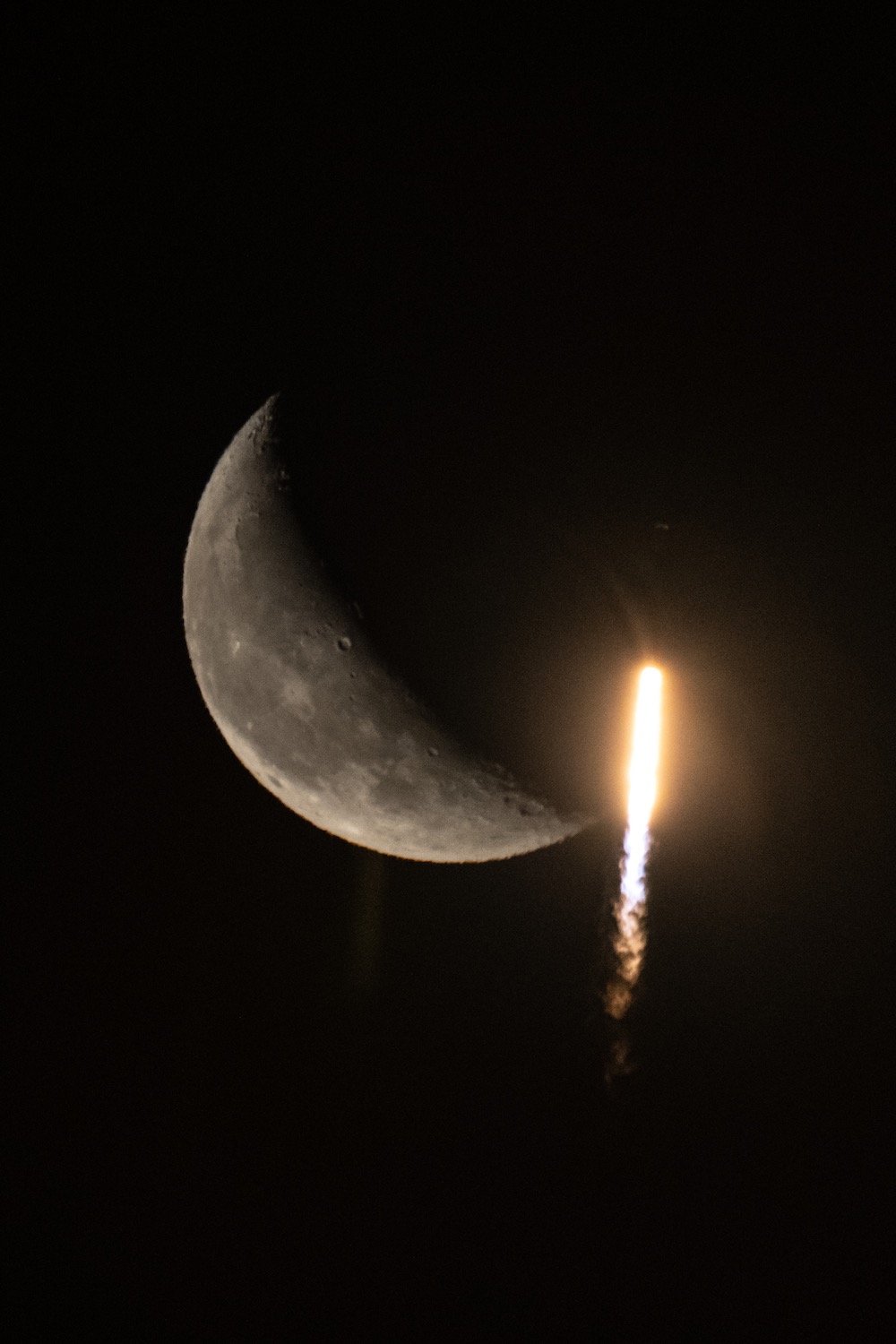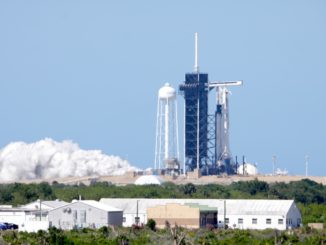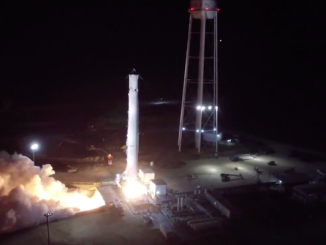Watch a replay of our live coverage of the countdown and launch of a SpaceX Falcon 9 rocket on the Starlink 5-11 mission at 3:10 a.m. EDT (0710 UTC) on June 12 from Space Launch Complex 40 at Cape Canaveral Space Force Station, Florida. Follow us on Twitter.
SFN Live
Launch Pad Live
SpaceX’s 40th launch of the year sent another batch of 52 Starlink internet satellites into orbit from Cape Canaveral early Monday aboard a Falcon 9 rocket.
Liftoff from pad 40 at Cape Canaveral Space Force Station occurred at 3:10 a.m. EDT (0710 UTC) Monday.
The mission followed a familiar track and timeline, with the Falcon 9 heading southeast from Florida’s Space Coast to place the 52 Starlink payloads into an orbit inclined 43 degrees to the equator. It took about 65 minutes from liftoff through separation of the Starlink satellites, which occurred over the Western Pacific Ocean.
Two braking burns slowed the rocket for landing on the drone ship “Just Read the Instructions” around 400 miles (640 kilometers) downrange approximately eight-and-a-half minutes after liftoff. The reusable booster, designated B1073 in SpaceX’s inventory, made its ninth trip to space.
The launch was the first of two Falcon 9 rockets scheduled to take off Monday, with SpaceX teams at Vandenberg Space Force Base in California preparing a Falcon 9 for liftoff about 14 hours after the flight from Florida at 5:19 p.m. EDT (2:19 p.m. PDT; 2119 UTC). The launch from California will haul a group of 72 small spacecraft and payloads into polar orbit for a range of U.S. and international customers on SpaceX’s eighth small satellite rideshare mission.
The Cape Canaveral launch, named Starlink 5-11 in SpaceX’s launch sequence, brought the total number of Starlink satellites SpaceX has launched to 4,595. The Starlink network provides high-speed, low-latency connectivity to customers around the world. SpaceX says each Starlink launch adds more than a terabit per second of capacity to the constellation.
SpaceX currently has more than 4,200 functioning Starlink satellites in space, with more than 3,500 operational spacecraft and more than 500 moving into their operational orbits, according to a tabulation by Jonathan McDowell, an expert tracker of spaceflight activity and an astronomer at the Harvard-Smithsonian Center for Astrophysics.
The rest of the Starlink satellites were prototypes or failed platforms that have been retired from service and guided back into the atmosphere to burn up on re-entry.
Monday’s mission continued deployment of SpaceX’s older-generation Starlink V1.5 satellites, following launches earlier this year that started placing a new generation of Starlink satellites in orbit. The new satellites, known as the Starlink V2 Mini design, are larger and offer four times the broadband capacity of the older-design satellites.
The new Starlink V2 Minis carry upgraded phase array antennas and a more efficient, higher-thrust argon-fueled electric propulsion system. They also have two solar arrays, compared to a single extendable solar panel on each Starlink V1.5 spacecraft.

The Starlink V1.5 satellites on Monday’s Starlink 5-11 mission were similar to the Starlink spacecraft SpaceX has launched over the last few years, but they headed into an orbital plane that is, at least in regulatory terms, part of SpaceX’s second-generation, or Gen2, network.
SpaceX started launching satellites into the Gen2 network in December, beginning the population of new orbital planes with older-design satellites until the larger Starlink spacecraft design is ready to take over entirely.
The Starlink V2 Mini satellites that SpaceX started launching in February represent an intermediate step between the smaller Starlink V1.5 spacecraft and the even larger full-size Starlink V2s, which SpaceX plans to deploy in orbit using the company’s new Starship mega-rocket.
The Federal Communications granted SpaceX approval Dec. 1 to launch up to 7,500 of its planned 29,988-spacecraft Starlink Gen2 constellation, which will spread out into slightly different orbits than the original Starlink fleet. The regulatory agency deferred a decision on the remaining satellites SpaceX proposed for Gen2.
Specifically, the FCC granted SpaceX authority to launch the initial block of 7,500 Starlink Gen2 satellites into orbits at 525, 530, and 535 kilometers, with inclinations of 53, 43, and 33 degrees, respectively, using Ku-band and Ka-band frequencies. The Starlink 5-11 mission Sunday targeted the 43-degree inclination orbit in the Starlink Gen2 constellation.
The first-generation Starlink network architecture includes satellites flying a few hundred miles up, orbiting at inclinations of 97.6 degrees, 70 degrees, 53.2 degrees, and 53.0 degrees to the equator. Last year, most of SpaceX’s Starlink launches have released satellites into Shell 4, at an inclination of 53.2 degrees, after the company largely completed launches into the first 53-degree inclination shell in 2021.
The FCC previously authorized SpaceX to launch and operate roughly 4,400 first-generation Ka-band and Ku-band Starlink spacecraft that SpaceX has been launching since 2019. SpaceX is in the final stages of populating the first-generation Starlink network.
The Gen2 satellites will improve Starlink coverage over lower latitude regions, and help alleviate pressure on the network from growing consumer uptake. SpaceX says the network has more than 1 million active subscribers, mostly households in areas where conventional fiber connectivity is unavailable, unreliable, or expensive. Users also include cruise ship companies, airlines, and military forces.
ROCKET: Falcon 9 (B1073.9)
PAYLOAD: 52 Starlink satellites (Starlink 5-11)
LAUNCH SITE: SLC-40, Cape Canaveral Space Force Station, Florida
LAUNCH DATE: June 12, 2023
LAUNCH TIME: 3:10:50 a.m. EDT (0710:50 UTC)
WEATHER FORECAST: 90% chance of acceptable weather; Low risk of upper level winds; Low risk of unfavorable conditions for booster recovery
BOOSTER RECOVERY: “A Shortfall of Gravitas” drone ship northeast of the Bahamas
LAUNCH AZIMUTH: Southeast
TARGET ORBIT: 185 miles by 210 miles (299 kilometers by 339 kilometers), 43.0 degrees inclination
LAUNCH TIMELINE:
- T+00:00: Liftoff
- T+01:12: Maximum aerodynamic pressure (Max-Q)
- T+02:25: First stage main engine cutoff (MECO)
- T+02:28: Stage separation
- T+02:35: Second stage engine ignition (SES 1)
- T+02:43: Fairing jettison
- T+06:14: First stage entry burn ignition (three engines)
- T+06:39: First stage entry burn cutoff
- T+08:02: First stage landing burn ignition (one engine)
- T+08:25: First stage landing
- T+08:35: Second stage engine cutoff (SECO 1)
- T+54:06: Second stage engine ignition (SES 2)
- T+54:08: Second stage engine cutoff (SECO 2)
- T+1:05:24: Starlink satellite separation
MISSION STATS:
- 231st launch of a Falcon 9 rocket since 2010
- 242nd launch of Falcon rocket family since 2006
- 9th launch of Falcon 9 booster B1073
- 172nd flight of a reused Falcon booster
- 195th SpaceX launch from Florida’s Space Coast
- 128th Falcon 9 launch from pad 40
- 183rd launch overall from pad 40
- 88th Falcon 9 launch primarily dedicated to Starlink network
- 37th Falcon 9 launch of 2023
- 40th launch by SpaceX in 2023
- 29th orbital launch attempt based out of Cape Canaveral in 2023
Email the author.
Follow Stephen Clark on Twitter: @StephenClark1.



